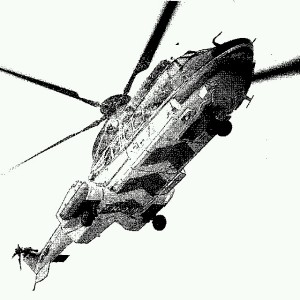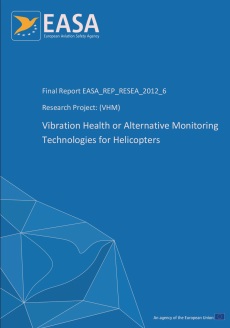EASA HUMS / VHM Research Developments
The European Aviation Safety Agency (EASA) has been funding some innovative research into Health and Usage Monitoring Systems (HUMS) / Vibration Health Monitoring (VHM).
EASA.2012.OP.13 VHM
Recently, Cranfield University‘s Matt Greaves presented to the International Society of Air Safety Investigators (ISASI) annual conference on one EASA research project (EASA.2012.OP.13 VHM). His paper was entitled: Towards the next generation of HUMS sensor.
At the beginning of the research 12 accident investigation reports were selected from 413 candidate reports for study. These covered a range of Sikorsky and Airbus Helicopters (nee Eurocopter) products of the 1960s onwards:
- SA330J 9M-SSC in 1980 (Main Gear Box [MGB] epicyclic failure)
- S-61N G-ASNL in 1983 (MGB failure)
- AS332L1 LN-OPG in 1997 (High Speed Shaft Failure)
- S-76A+ G-BJVX in 2001 (Main Rotor Blade [MRB] failure)
- S-61N G-BBHM in 2002 (Engine Oil Fire/Structural Failure)
- S-61N C-FHHD in 2002 (MGB failure after oil loss and fire)
- AS332L2 G-JSAR in 2003 (Accessory Gear Box [AGB] failure)
- AS332L G-PUMI in 2006 (Main Rotor Spindle crack)
- AS332L2 G-CHCF in 2007 (Freewheel Unit [FWU] failure)
- S-92A C-GZCH in 2009 (MGB failure after oil loss)
- AS332L2 G-REDL in 2009 (MGB epicyclic failure)
- EC225s G-REDW/G-CHCN in 2012 (MGB shaft failure)

The investigations into the 2010 accidents to AS332L2 B-HRN in 2010 (a FWU failure) and AgustaWestland AW139 B-MHJ (a Tail Rotor Blade [TRB] failure) were on-going at the time and so were not included in the analysis.
Fault tree analysis (FTA) was performed on each of the 12 selected case studies. The key failure modes identified :
- Small corrosion pits as triggers of cracks
- Small machining defects as triggers of cracks
- Sub-surface cracks
- Possible spalling of gears/ bearings
- Material defects/ manufacturing anomalies
- Galling of studs/ bolts
- Wear due to load variations/ movements Fracture/ rupture under overload
- Deformation under overload of bearing rollers/ raceways/ gear teeth/ shafts/ splines
- Internal residual hoop/ tension/ torsion/ compression/ buckling stresses
- Permanent distortion (creep) of casings
- Seizure of roller bearing
- Improper coating of hardmetal (carbide grains size, porosity, coating thickness, etc)
- Lamination of the hard metal coating
- Defective bonding between hard metal and coating
The Cranfield University analysis showed that while these occurrences showed some similarities there were no consistent patterns. Hence it was decided to concentrate on the most serious, the epicyclic failure on G-REDL.
The project the looked to test alternative sensor technologies. However the MGB epicyclic stage is a challenging location for mounting sensors because of:
- Rotation
- Oil
- Faraday cage
- Large rotating metallic components
- Temperature
- Vibration levels
- Difficulties transferring power
- Limited Space
- Risk of damage to gears
A number of design constraints were imposed:
- No mechanical signal connection (e.g. slip rings) – wireless only
- Limited space (of the order of 1 cm at most)
- Useful operating temperature range -10˚C to +130˚C
- Sensor weight below 10g
- Tolerant of gearbox mineral oil
- Powered inside MGB without a battery
- Guaranteed attachment, or no risk from sensor if detached
Having considered various options he trial focused on acoustic emission (AE) sensor technology.
AE is misnamed technology because, as Greaves points out, it is ‘Neither acoustic nor emitted’. AE was previously trialled but abandoned in UK Civil Aviation Authority (CAA) research in the 1990s. However, Greaves explains that:
AE measurement is the capture of high frequency (hundreds of kilohertz) surface stress waves that are produced in structures by applied forces. The potential of this technology has increased dramatically over the last 10 years due to improvements in sensor and data acquisition technology such that it is now established as a condition monitoring tool.
The project also developed a new approach for wireless transmission of AE signals which could lead to more deeply embedded sensors (thus improving performance) and the prospect of retro-fitting sensors in future.
Both technologies were tested both on a test rig at Cranfield and full scale on an ex-Royal Air Force SA330 Puma HC1 gearbox, tested at the Airbus Helicopters’ facility in Marignane.
The report is due out early in 2015.
UPDATE December 2014: Matt Graves also presented the results of research project EASA.2012.OP.13 VHM at EASA’s 8th Rotorcraft Symposium last month in Cologne. That presentation is downloadable as part of a large zip file for the whole symposium or directly here 2.2._Greaves_Results from EASA project 2012.OP.13 – VHM.
EASA.2014.OP.15 MGH
EASA has also recently issued a call for tender for a follow on project EASA.2014.OP.15, Helicopter main gearbox health (MGH). The two objectives of this project are:
…to investigate new fault detection techniques and associated technologies for monitoring the health of the helicopter rotor and transmission systems in comparison to existing techniques (used for large helicopters) employed by Health and Usage Monitoring Systems (HUMS). A particular focus, as highlighted by the UK-AAIB, concerns the main gearbox and the epicyclic module. The scope of these activities covers the provision of health data to support maintenance actions and possibly provision of information to the pilots during operations. The environment of a helicopter main gearbox (MGB) in terms of space and weight constraints, temperature, lubrication, etc. will be taken into account to assess the integration of proposed new fault detection techniques. A comparison with current HUMS techniques currently used for large helicopters will also be performed.
…to run a series of investigations and tests to assess the potential mitigations against loss of MGB oil in flight. The system developed for the tests on incipient failure detection, utilising internal sensors, will be reused to monitor internal planet gear temperatures, vibration and acoustic emission characteristics.
The second objective follows the Helicopter Main Gearbox Loss of Oil Performance Optimisation (HELMGOP) project EASA commissioned in 2011, also conducted by Cranfield University. That project has already had a second phase of testing in parallel with the work Greaves reported on. This loss of lubrication research is associated with rule making activity previously discussed by Aerossurance, that followed the S-92A accident offshore Canada in 2009.
UPDATE 7 January 2015: We have more on EASA and FAA HUMS / VHM research here.
UPDATE 3 July 2016: Also see: EC225 LN-OJF Norway Accident Investigation Timeline
UPDATE 9 May 2017: The Cranfield University report on EASA.2012.OP.13 VHM is now available at: EASA_REP_RESEA_2012_6 Vibration Health Monitoring or Alternative Techniques for Helicopters (note 45Mb!).
The research programme has shown that internal sensors for helicopter main rotor gearboxes are feasible and that they are able to offer improved detection when compared with traditional external vibration measurements.
UPDATE 6 June 2017: We expand on the recent AIBN report on the LN-OJF EC225 accident: Super Puma Epicyclic Gear Health Monitoring Background
For proven helicopter safety, transmission design and HUMS/VHM expertise, contact Aberdeen based aviation consultancy Aerossurance at enquiries@aerossurance.com
Follow us on LinkedIn and on Twitter @Aerossurance for our latest updates.


Recent Comments